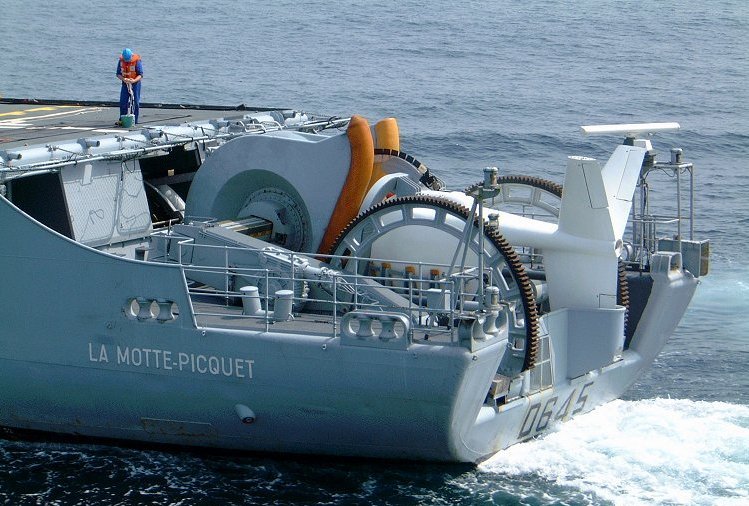|
Parametric Array
A parametric array, in the field of acoustics, is a nonlinear transducer, transduction mechanism that generates narrow, nearly side lobe-free beams of low frequency sound, through the mixing and interaction of high frequency sound waves, effectively overcoming the diffraction limit (a kind of spatial 'uncertainty principle') associated with linear acoustics. The main side lobe-free beam of low frequency sound is created as a result of nonlinear mixing of two high frequency sound beams at their difference frequency. Parametric arrays can be formed in water, air, and earth materials/rock. History Priority for discovery and explanation of the parametric array owes to Peter Westervelt, Peter J. Westervelt, winner of the Lord Rayleigh Medal, although important experimental work was contemporaneously underway in the former Soviet Union. According to Muir and Albers, the concept for the parametric array occurred to Dr. Westervelt while he was stationed at the London, England, branch offi ... [...More Info...] [...Related Items...] OR: [Wikipedia] [Google] [Baidu] |
Acoustics
Acoustics is a branch of physics that deals with the study of mechanical waves in gases, liquids, and solids including topics such as vibration, sound, ultrasound and infrasound. A scientist who works in the field of acoustics is an acoustician while someone working in the field of acoustics technology may be called an Acoustical engineering, acoustical engineer. The application of acoustics is present in almost all aspects of modern society with the most obvious being the audio and noise control industries. Hearing (sense), Hearing is one of the most crucial means of survival in the animal world and speech is one of the most distinctive characteristics of human development and culture. Accordingly, the science of acoustics spreads across many facets of human society—music, medicine, architecture, industrial production, warfare and more. Likewise, animal species such as songbirds and frogs use sound and hearing as a key element of mating rituals or for marking territories. Art, ... [...More Info...] [...Related Items...] OR: [Wikipedia] [Google] [Baidu] |
Green's Functions
In mathematics, a Green's function (or Green function) is the impulse response of an inhomogeneous linear differential operator defined on a domain with specified initial conditions or boundary conditions. This means that if L is a linear differential operator, then * the Green's function G is the solution of the equation where \delta is Dirac's delta function; * the solution of the initial-value problem L y = f is the convolution Through the superposition principle, given a linear ordinary differential equation (ODE), one can first solve for each , and realizing that, since the source is a sum of delta functions, the solution is a sum of Green's functions as well, by linearity of . Green's functions are named after the British mathematician George Green, who first developed the concept in the 1820s. In the modern study of linear partial differential equations, Green's functions are studied largely from the point of view of fundamental solutions instead. Under many- ... [...More Info...] [...Related Items...] OR: [Wikipedia] [Google] [Baidu] |
Sound
In physics, sound is a vibration that propagates as an acoustic wave through a transmission medium such as a gas, liquid or solid. In human physiology and psychology, sound is the ''reception'' of such waves and their ''perception'' by the brain. Only acoustic waves that have frequency, frequencies lying between about 20 Hz and 20 kHz, the audio frequency range, elicit an auditory percept in humans. In air at atmospheric pressure, these represent sound waves with wavelengths of to . Sound waves above 20 kHz are known as ultrasound and are not audible to humans. Sound waves below 20 Hz are known as infrasound. Different animal species have varying hearing ranges, allowing some to even hear ultrasounds. Definition Sound is defined as "(a) Oscillation in pressure, stress, particle displacement, particle velocity, etc., propagated in a medium with internal forces (e.g., elastic or viscous), or the superposition of such propagated oscillation. (b) Auditory sen ... [...More Info...] [...Related Items...] OR: [Wikipedia] [Google] [Baidu] |
Elwood Norris Receives 2005 Lemelson-MIT Prize For Invention
Elwood may refer to the following: Places In Australia * Elwood, Victoria, a suburb of Melbourne In the United States * Elwood, Illinois, a village * Elwood, Indiana, a city * Elwood, Kansas, a city * Elwood, Missouri, an unincorporated community * Elwood, Nebraska, a village * Elwood, New Jersey, an unincorporated community and census-designated place * Elwood, New York, a census-designated place * Elwood, Utah, a town People First name * Elwood Balderston (died 1921), American politician * Elwood Thomas Baker (1854–1938), co-inventor of the card game gin rummy * Elwood Barker (1878–1953), American politician * Elwood Blues, a fictional character portrayed by Dan Aykroyd in the 1980 film ''The Blues Brothers'' * Elwood Engel (1917–1986), Chrysler Corporation's design chief from 1961 until 1974 * Elwood Francis, a member of the American rock group ZZ Top * E. Gordon Gee (born 1944), American academic administrator, President of West Virginia University * Elwood ... [...More Info...] [...Related Items...] OR: [Wikipedia] [Google] [Baidu] |
Sound From Ultrasound
Sound from ultrasound is the name given here to the generation of audible sound from modulated ultrasound without using an active receiver. This happens when the modulated ultrasound passes through a nonlinear medium which acts, intentionally or unintentionally, as a demodulator. Parametric array Since the early 1960s, researchers have been experimenting with creating directive low-frequency sound from nonlinear interaction of an aimed beam of ultrasound waves produced by a parametric array using heterodyning. Ultrasound has much shorter wavelengths than audible sound, so that it propagates in a much narrower beam than any normal loudspeaker system using audio frequencies. Most of the work was performed in liquids (for underwater sound use). The first modern device for air acoustic use was created in 1998,105th AES Conv, Preprint 4853, 1998 and is now known by the trademark name "Audio Spotlight", a term first coined in 1983 by the Japanese researchers who abandoned the technolog ... [...More Info...] [...Related Items...] OR: [Wikipedia] [Google] [Baidu] |
Ultrasound
Ultrasound is sound with frequency, frequencies greater than 20 Hertz, kilohertz. This frequency is the approximate upper audible hearing range, limit of human hearing in healthy young adults. The physical principles of acoustic waves apply to any frequency range, including ultrasound. Ultrasonic devices operate with frequencies from 20 kHz up to several gigahertz. Ultrasound is used in many different fields. Ultrasonic devices are used to detect objects and measure distances. Ultrasound imaging or sonography is often used in medicine. In the nondestructive testing of products and structures, ultrasound is used to detect invisible flaws. Industrially, ultrasound is used for cleaning, mixing, and accelerating chemical processes. Animals such as bats and porpoises use ultrasound for locating prey and obstacles. History Acoustics, the science of sound, starts as far back as Pythagoras in the 6th century BC, who wrote on the mathematical properties of String instrument ... [...More Info...] [...Related Items...] OR: [Wikipedia] [Google] [Baidu] |
Sonar
Sonar (sound navigation and ranging or sonic navigation and ranging) is a technique that uses sound propagation (usually underwater, as in submarine navigation) to navigate, measure distances ( ranging), communicate with or detect objects on or under the surface of the water, such as other vessels. "Sonar" can refer to one of two types of technology: ''passive'' sonar means listening for the sound made by vessels; ''active'' sonar means emitting pulses of sounds and listening for echoes. Sonar may be used as a means of acoustic location and of measurement of the echo characteristics of "targets" in the water. Acoustic location in air was used before the introduction of radar. Sonar may also be used for robot navigation, and sodar (an upward-looking in-air sonar) is used for atmospheric investigations. The term ''sonar'' is also used for the equipment used to generate and receive the sound. The acoustic frequencies used in sonar systems vary from very low ( infrasonic) to e ... [...More Info...] [...Related Items...] OR: [Wikipedia] [Google] [Baidu] |
Sound Intensity
Sound intensity, also known as acoustic intensity, is defined as the power carried by sound waves per unit area in a direction perpendicular to that area, also called the sound power density and the sound energy flux density. The SI unit of intensity, which includes sound intensity, is the watt per square meter (W/m2). One application is the noise measurement of sound intensity in the air at a listener's location as a sound energy quantity. Sound intensity is not the same physical quantity as sound pressure. Human hearing is sensitive to sound pressure which is related to sound intensity. In consumer audio electronics, the level differences are called "intensity" differences, but sound intensity is a specifically defined quantity and cannot be sensed by a simple microphone. Sound intensity level is a logarithmic expression of sound intensity relative to a reference intensity. Mathematical definition Sound intensity, denoted I, is defined by \mathbf I = p \mathbf v where * '' ... [...More Info...] [...Related Items...] OR: [Wikipedia] [Google] [Baidu] |
Wavenumber
In the physical sciences, the wavenumber (or wave number), also known as repetency, is the spatial frequency of a wave. Ordinary wavenumber is defined as the number of wave cycles divided by length; it is a physical quantity with dimension of reciprocal length, expressed in SI units of cycles per metre or reciprocal metre (m−1). Angular wavenumber, defined as the wave phase divided by time, is a quantity with dimension of angle per length and SI units of radians per metre. They are analogous to temporal frequency, respectively the '' ordinary frequency'', defined as the number of wave cycles divided by time (in cycles per second or reciprocal seconds), and the ''angular frequency'', defined as the phase angle divided by time (in radians per second). In multidimensional systems, the wavenumber is the magnitude of the '' wave vector''. The space of wave vectors is called ''reciprocal space''. Wave numbers and wave vectors play an essential role in optics and the physics ... [...More Info...] [...Related Items...] OR: [Wikipedia] [Google] [Baidu] |
Fourier Operator
The Fourier operator is the integral kernel, kernel of the Fredholm integral equation#Equation of the first kind, Fredholm integral of the first kind that defines the continuous Fourier transform, and is a two-dimensional function when it corresponds to the Fourier transform of one-dimensional functions. It is complex-valued and has a constant (typically unity) magnitude everywhere. When depicted, e.g. for teaching purposes, it may be visualized by its separate real and imaginary parts, or as a colour image using a colour wheel to denote phase. It is usually denoted by a capital letter "F" in script font (\mathcal), e.g. the Fourier transform of a function g(t) would be written using the operator as \mathcalg(t). It may be thought of as a limiting case (mathematics), limiting case for when the size of the discrete Fourier transform increases without bound while its spatial resolution also increases without bound, so as to become both continuous and not necessarily periodic. Visua ... [...More Info...] [...Related Items...] OR: [Wikipedia] [Google] [Baidu] |
Aeroacoustics
Aeroacoustics is a branch of acoustics that studies noise generation via either turbulent fluid motion or aerodynamic forces interacting with surfaces. Noise generation can also be associated with periodically varying flows. A notable example of this phenomenon is the Aeolian tones produced by wind blowing over fixed objects. Although no complete scientific theory of the generation of noise by aerodynamic flows has been established, most practical aeroacoustic analysis relies upon the so-called '' aeroacoustic analogy'', proposed by Sir James Lighthill in the 1950s while at the University of Manchester. whereby the governing equations of motion of the fluid are coerced into a form reminiscent of the wave equation of "classical" (i.e. linear) acoustics in the left-hand side with the remaining terms as sources in the right-hand side. History The modern discipline of aeroacoustics can be said to have originated with the first publication of Lighthill in the early 1950s, when nois ... [...More Info...] [...Related Items...] OR: [Wikipedia] [Google] [Baidu] |



